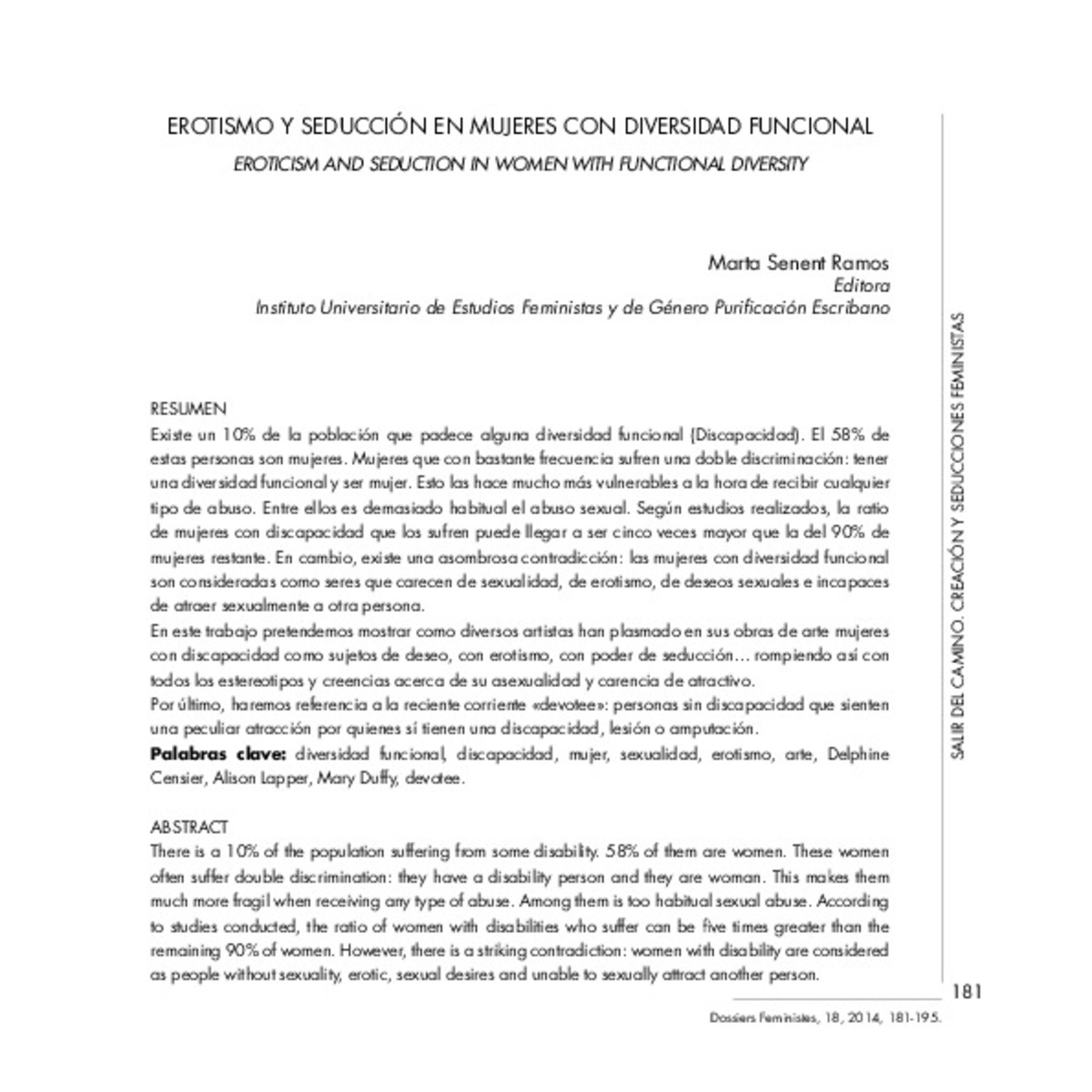Mostrar el registro sencillo del ítem
EROTISMO Y SEDUCCIÓN EN MUJERES CON DIVERSIDAD FUNCIONAL
| dc.contributor.author | Senent Ramos, Marta | |
| dc.date.accessioned | 2015-11-27T10:35:53Z | |
| dc.date.available | 2015-11-27T10:35:53Z | |
| dc.date.issued | 2014 | |
| dc.identifier.issn | 1139-1219 | |
| dc.identifier.issn | 2340-4930 | |
| dc.identifier.uri | http://hdl.handle.net/10234/141667 | |
| dc.description.abstract | Existe un 10% de la población que padece alguna diversidad funcional (Discapacidad). El 58% de estas personas son mujeres. Mujeres que con bastante frecuencia sufren una doble discriminación: tener una diversidad funcional y ser mujer. Esto las hace mucho más vulnerables a la hora de recibir cualquier tipo de abuso. Entre ellos es demasiado habitual el abuso sexual. Según estudios realizados, la ratio de mujeres con discapacidad que los sufren puede llegar a ser cinco veces mayor que la del 90% de mujeres restante. En cambio, existe una asombrosa contradicción: las mujeres con diversidad funcional son consideradas como seres que carecen de sexualidad, de erotismo, de deseos sexuales e incapaces de atraer sexualmente a otra persona. En este trabajo pretendemos mostrar como diversos artistas han plasmado en sus obras de arte mujeres con discapacidad como sujetos de deseo, con erotismo, con poder de seducción… rompiendo así con todos los estereotipos y creencias acerca de su asexualidad y carencia de atractivo. Por último, haremos referencia a la reciente corriente «devotee»: personas sin discapacidad que sienten una peculiar atracción por quienes sí tienen una discapacidad, lesión o amputación. | ca_CA |
| dc.description.abstract | There is a 10% of the population suffering from some disability. 58% of them are women. These women often suffer double discrimination: they have a disability person and they are woman. This makes them much more fragil when receiving any type of abuse. Among them is too habitual sexual abuse. According to studies conducted, the ratio of women with disabilities who suffer can be five times greater than the remaining 90% of women. However, there is a striking contradiction: women with disability are considered as people without sexuality, erotic, sexual desires and unable to sexually attract another person. n this job, we show how various artists have captured in their artwork disabled women as subjects of desire, erotic, seduction ... breaking all the stereotypes and beliefs about their asexuality and lack of appeal. Finally, we refer to the recent stream «devotee» people without disabled who feel a particular attraction for who have a disability, injury or amputation. | ca_CA |
| dc.format.mimetype | application/pdf | ca_CA |
| dc.language.iso | spa | ca_CA |
| dc.publisher | Universitat Jaume I. Institut Universitari d'Estudis Feministes i de Gènere | ca_CA |
| dc.relation.isPartOf | Dossiers Feministes, núm.18 | ca_CA |
| dc.rights.uri | http://rightsstatements.org/vocab/CNE/1.0/ | * |
| dc.subject | diversidad funcional | ca_CA |
| dc.subject | discapacidad | ca_CA |
| dc.subject | mujer | ca_CA |
| dc.subject | sexualidad | ca_CA |
| dc.subject | erotismo | ca_CA |
| dc.subject | arte | ca_CA |
| dc.subject | Delphine Censier | ca_CA |
| dc.subject | Alison Lapper | ca_CA |
| dc.subject | Mary Duffy | ca_CA |
| dc.subject | devotee | ca_CA |
| dc.subject | disability | ca_CA |
| dc.subject | women | ca_CA |
| dc.subject | sexuality | ca_CA |
| dc.subject | erotic | ca_CA |
| dc.subject | art | ca_CA |
| dc.subject | Delphine Censier | ca_CA |
| dc.subject | Alison Lapper | ca_CA |
| dc.subject | Mary Duffy | ca_CA |
| dc.subject | devotee | ca_CA |
| dc.subject.other | Dones -- Revistes | ca_CA |
| dc.subject.other | Feminisme -- Revistes | ca_CA |
| dc.title | EROTISMO Y SEDUCCIÓN EN MUJERES CON DIVERSIDAD FUNCIONAL | ca_CA |
| dc.title.alternative | EROTICISM AND SEDUCTION IN WOMEN WITH FUNCTIONAL DIVERSITY | ca_CA |
| dc.type | info:eu-repo/semantics/article | ca_CA |
| dc.rights.accessRights | info:eu-repo/semantics/openAccess | ca_CA |
| dc.relation.publisherVersion | http://www.e-revistes.uji.es/index.php/dossiers/article/view/1234/1251 | ca_CA |







